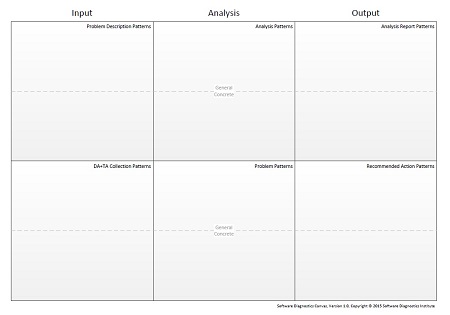 Multiple Exceptions (user mode) - Modeling Example
Multiple Exceptions (user mode) - Modeling Example Multiple Exceptions (kernel mode)
Multiple Exceptions (kernel mode) Multiple Exceptions (managed space)
Multiple Exceptions (managed space)- Multiple Exceptions (stowed)
 Dynamic Memory Corruption (process heap)
Dynamic Memory Corruption (process heap) Dynamic Memory Corruption (kernel pool)
Dynamic Memory Corruption (kernel pool)- Dynamic Memory Corruption (managed heap)
 False Positive Dump
False Positive Dump Lateral Damage (general)
Lateral Damage (general)- Lateral Damage (CPU mode)
 Optimized Code (function parameter reuse)
Optimized Code (function parameter reuse) Invalid Pointer (general)
Invalid Pointer (general)- Invalid Pointer (objects)
 NULL Pointer (code)
NULL Pointer (code) NULL Pointer (data)
NULL Pointer (data) Inconsistent Dump
Inconsistent Dump Hidden Exception (user space)
Hidden Exception (user space)- Hidden Exception (kernel space)
- Hidden Exception (managed space)
 Deadlock (critical sections)
Deadlock (critical sections) Deadlock (executive resources)
Deadlock (executive resources) Deadlock (mixed objects, user space)
Deadlock (mixed objects, user space) Deadlock (LPC)
Deadlock (LPC) Deadlock (mixed objects, kernel space)
Deadlock (mixed objects, kernel space) Deadlock (self)
Deadlock (self)- Deadlock (managed space)
- Deadlock (.NET Finalizer)
 Changed Environment
Changed Environment Incorrect Stack Trace
Incorrect Stack Trace OMAP Code Optimization
OMAP Code Optimization No Component Symbols
No Component Symbols Insufficient Memory (committed memory)
Insufficient Memory (committed memory) Insufficient Memory (handle leak)
Insufficient Memory (handle leak) Insufficient Memory (kernel pool)
Insufficient Memory (kernel pool) Insufficient Memory (PTE)
Insufficient Memory (PTE) Insufficient Memory (module fragmentation)
Insufficient Memory (module fragmentation) Insufficient Memory (physical memory)
Insufficient Memory (physical memory) Insufficient Memory (control blocks)
Insufficient Memory (control blocks)- Insufficient Memory (reserved virtual memory)
- Insufficient Memory (session pool)
- Insufficient Memory (stack trace database)
- Insufficient Memory (region)
- Insufficient Memory (stack)
 Spiking Thread
Spiking Thread Module Variety
Module Variety Stack Overflow (kernel mode)
Stack Overflow (kernel mode) Stack Overflow (user mode)
Stack Overflow (user mode) Stack Overflow (software implementation)
Stack Overflow (software implementation)- Stack Overflow (insufficient memory)
- Stack Overflow (managed space)
 Managed Code Exception
Managed Code Exception- Managed Code Exception (Scala)
- Managed Code Exception (Python)
 Truncated Dump
Truncated Dump Waiting Thread Time (kernel dumps)
Waiting Thread Time (kernel dumps) Waiting Thread Time (user dumps)
Waiting Thread Time (user dumps) Memory Leak (process heap) - Modeling Example
Memory Leak (process heap) - Modeling Example Memory Leak (.NET heap)
Memory Leak (.NET heap)- Memory Leak (page tables)
- Memory Leak (I/O completion packets)
- Memory Leak (regions)
 Missing Thread (user space)
Missing Thread (user space)- Missing Thread (kernel space)
 Unknown Component
Unknown Component Double Free (process heap)
Double Free (process heap) Double Free (kernel pool)
Double Free (kernel pool) Coincidental Symbolic Information
Coincidental Symbolic Information Stack Trace
Stack Trace- Stack Trace (I/O request)
- Stack Trace (file system filters)
- Stack Trace (database)
- Stack Trace (I/O devices)
 Virtualized Process (WOW64)
Virtualized Process (WOW64)- Virtualized Process (ARM64CE and CHPE)
 Stack Trace Collection (unmanaged space)
Stack Trace Collection (unmanaged space)- Stack Trace Collection (managed space)
- Stack Trace Collection (predicate)
- Stack Trace Collection (I/O requests)
- Stack Trace Collection (CPUs)
 Coupled Processes (strong)
Coupled Processes (strong) Coupled Processes (weak)
Coupled Processes (weak) Coupled Processes (semantics)
Coupled Processes (semantics) High Contention (executive resources)
High Contention (executive resources) High Contention (critical sections)
High Contention (critical sections) High Contention (processors)
High Contention (processors)- High Contention (.NET CLR monitors)
- High Contention (.NET heap)
- High Contention (sockets)
 Accidental Lock
Accidental Lock Passive Thread (user space)
Passive Thread (user space) Passive System Thread (kernel space)
Passive System Thread (kernel space) Main Thread
Main Thread Busy System
Busy System Historical Information
Historical Information Object Distribution Anomaly (IRP)
Object Distribution Anomaly (IRP)- Object Distribution Anomaly (.NET heap)
 Local Buffer Overflow (user space)
Local Buffer Overflow (user space)- Local Buffer Overflow (kernel space)
 Early Crash Dump
Early Crash Dump Hooked Functions (user space)
Hooked Functions (user space) Hooked Functions (kernel space)
Hooked Functions (kernel space)- Hooked Modules
 Custom Exception Handler (user space)
Custom Exception Handler (user space) Custom Exception Handler (kernel space)
Custom Exception Handler (kernel space) Special Stack Trace
Special Stack Trace Manual Dump (kernel)
Manual Dump (kernel) Manual Dump (process)
Manual Dump (process) Wait Chain (general)
Wait Chain (general) Wait Chain (critical sections)
Wait Chain (critical sections) Wait Chain (executive resources)
Wait Chain (executive resources) Wait Chain (thread objects)
Wait Chain (thread objects) Wait Chain (LPC/ALPC)
Wait Chain (LPC/ALPC) Wait Chain (process objects)
Wait Chain (process objects) Wait Chain (RPC)
Wait Chain (RPC) Wait Chain (window messaging)
Wait Chain (window messaging) Wait Chain (named pipes)
Wait Chain (named pipes)- Wait Chain (mutex objects)
- Wait Chain (pushlocks)
- Wait Chain (CLR monitors)
- Wait Chain (RTL_RESOURCE)
- Wait Chain (modules)
- Wait Chain (nonstandard synchronization)
- Wait Chain (C++11, condition variable)
- Wait Chain (SRW lock)
 Corrupt Dump
Corrupt Dump Dispatch Level Spin
Dispatch Level Spin No Process Dumps
No Process Dumps No System Dumps
No System Dumps Suspended Thread
Suspended Thread Special Process
Special Process Frame Pointer Omission
Frame Pointer Omission False Function Parameters
False Function Parameters Message Box
Message Box Self-Dump
Self-Dump Blocked Thread (software)
Blocked Thread (software) Blocked Thread (hardware)
Blocked Thread (hardware)- Blocked Thread (timeout)
 Zombie Processes
Zombie Processes Wild Pointer
Wild Pointer Wild Code
Wild Code Hardware Error
Hardware Error Handle Limit (GDI, kernel space)
Handle Limit (GDI, kernel space)- Handle Limit (GDI, user space)
 Missing Component (general)
Missing Component (general) Missing Component (static linking, user mode)
Missing Component (static linking, user mode) Execution Residue (unmanaged space, user)
Execution Residue (unmanaged space, user)- Execution Residue (unmanaged space, kernel)
- Execution Residue (managed space)
 Optimized VM Layout
Optimized VM Layout- Invalid Handle (general)
- Invalid Handle (managed space)
- Overaged System
- Thread Starvation (realtime priority)
- Thread Starvation (normal priority)
- Duplicated Module
- Not My Version (software)
- Not My Version (hardware)
- Data Contents Locality
- Nested Exceptions (unmanaged code)
- Nested Exceptions (managed code)
- Affine Thread
- Self-Diagnosis (user mode)
- Self-Diagnosis (kernel mode)
- Self-Diagnosis (registry)
- Inline Function Optimization (unmanaged code)
- Inline Function Optimization (managed code)
- Critical Section Corruption
- Lost Opportunity
- Young System
- Last Error Collection
- Hidden Module
- Data Alignment (page boundary)
- C++ Exception
- Divide by Zero (user mode)
- Divide by Zero (kernel mode)
- Swarm of Shared Locks
- Process Factory
- Paged Out Data
- Semantic Split
- Pass Through Function
- JIT Code (.NET)
- JIT Code (Java)
- Ubiquitous Component (user space)
- Ubiquitous Component (kernel space)
- Nested Offender
- Virtualized System
- Effect Component
- Well-Tested Function
- Mixed Exception
- Random Object
- Missing Process
- Platform-Specific Debugger
- Value Deviation (stack trace)
- Value Deviation (structure field)
- Runtime Thread (CLR)
- Runtime Thread (Python, Linux)
- Coincidental Frames
- Fault Context
- Hardware Activity
- Incorrect Symbolic Information
- Message Hooks - Modeling Example
- Coupled Machines
- Abridged Dump
- Exception Stack Trace
- Distributed Spike
- Instrumentation Information
- Template Module
- Invalid Exception Information
- Shared Buffer Overwrite
- Pervasive System
- Problem Exception Handler
- Same Vendor
- Crash Signature
- Blocked Queue (LPC/ALPC)
- Fat Process Dump
- Invalid Parameter (process heap)
- Invalid Parameter (runtime function)
- String Parameter
- Well-Tested Module
- Embedded Comment
- Hooking Level
- Blocking Module
- Dual Stack Trace
- Environment Hint
- Top Module
- Livelock
- Technology-Specific Subtrace (COM interface invocation)
- Technology-Specific Subtrace (dynamic memory)
- Technology-Specific Subtrace (JIT .NET code)
- Technology-Specific Subtrace (COM client call)
- Dialog Box
- Instrumentation Side Effect
- Semantic Structure (PID.TID)
- Directing Module
- Least Common Frame
- Truncated Stack Trace
- Data Correlation (function parameters)
- Data Correlation (CPU times)
- Module Hint
- Version-Specific Extension
- Cloud Environment
- No Data Types
- Managed Stack Trace
- Managed Stack Trace (Scala)
- Managed Stack Trace (Python)
- Coupled Modules
- Thread Age
- Unsynchronized Dumps
- Pleiades
- Quiet Dump
- Blocking File
- Problem Vocabulary
- Activation Context
- Stack Trace Set
- Double IRP Completion
- Caller-n-Callee
- Annotated Disassembly (JIT .NET code)
- Annotated Disassembly (unmanaged code)
- Handled Exception (user space)
- Handled Exception (.NET CLR)
- Handled Exception (kernel space)
- Duplicate Extension
- Special Thread (.NET CLR)
- Hidden Parameter
- FPU Exception
- Module Variable
- System Object
- Value References
- Debugger Bug
- Empty Stack Trace
- Problem Module
- Disconnected Network Adapter
- Network Packet Buildup
- Unrecognizable Symbolic Information
- Translated Exception
- Regular Data
- Late Crash Dump
- Blocked DPC
- Coincidental Error Code
- Punctuated Memory Leak
- No Current Thread
- Value Adding Process
- Activity Resonance
- Stored Exception
- Spike Interval
- Stack Trace Change
- Unloaded Module
- Deviant Module
- Paratext
- Incomplete Session
- Error Reporting Fault
- First Fault Stack Trace
- Frozen Process
- Disk Packet Buildup
- Hidden Process
- Active Thread (Mac OS X)
- Active Thread (Windows)
- Critical Stack Trace
- Handle Leak
- Module Collection
- Module Collection (predicate)
- Deviant Token
- Step Dumps
- Broken Link
- Debugger Omission
- Glued Stack Trace
- Reduced Symbolic Information
- Injected Symbols
- Distributed Wait Chain
- One-Thread Process
- Module Product Process
- Crash Signature Invariant
- Small Value
- Shared Structure
- Thread Cluster
- False Effective Address
- Screwbolt Wait Chain
- Design Value
- Hidden IRP
- Tampered Dump
- Memory Fluctuation (process heap)
- Last Object
- Rough Stack Trace (unmanaged space)
- Rough Stack Trace (managed space)
- Past Stack Trace
- Ghost Thread
- Dry Weight
- Exception Module
- Reference Leak
- Origin Module
- Hidden Call
- Corrupt Structure
- Software Exception
- Crashed Process
- Variable Subtrace
- User Space Evidence
- Internal Stack Trace
- Distributed Exception (managed code)
- Thread Poset
- Stack Trace Surface
- Hidden Stack Trace
- Evental Dumps
- Clone Dump
- Parameter Flow
- Critical Region
- Diachronic Module
- Constant Subtrace
- Not My Thread
- Window Hint
- Place Trace
- Stack Trace Signature
- Relative Memory Leak
- Quotient Stack Trace
- Module Stack Trace
- Foreign Module Frame
- Unified Stack Trace
- Mirror Dump Set
- Memory Fibration
- Aggregated Frames
- Frame Regularity
- Stack Trace Motif
- System Call
- Stack Trace Race
- Hyperdump
- Disassembly Ambiguity
- Exception Reporting Thread
- Active Space
- Subsystem Modules
- Region Profile
- Region Clusters
- Source Stack Trace
- Hidden Stack
- Interrupt Stack
- False Memory
- Frame Trace
- Pointer Cone
- Context Pointer
- Pointer Class
- False Frame
- Procedure Call Chain
- C++ Object
- COM Exception
- Structure Sheaf
- Saved Exception Context (.NET)
- Shared Thread
- Spiking Interrupts
- Structure Field Collection
- Black Box
- Rough Stack Trace Collection (unmanaged space)
- COM Object
- Shared Page
- Exception Collection
- Dereference Nearpoint
- Address Representations
- Near Exception
- Shadow Stack Trace
- Past Process
- Foreign Stack
- Annotated Stack Trace
- Disassembly Summary
- Region Summary
- Analysis Summary
- Region Spectrum
- Normalized Region
- Function Pointer
- Interrupt Stack Collection
- DPC Stack Collection
- Dump Context
Pattern-Oriented Diagnostic Analysis Process
Previously we introduced Pattern-Oriented Debugging Process where software diagnostics played the major role as a part of debugging. However, in the case of a separate software diagnostic process, we introduce Pattern-Oriented Diagnostic Analysis Process, that incorporates diagnostic analysis requirements elicitation from problem description analysis and diagnostic report construction. Both new additions require separate pattern catalogs. Problem description analysis pattern catalog is already being extended, and the new catalog for diagnostic report construction is under development and will be published soon. The central process part, diagnostic artifact analysis, already has two extensive analysis pattern catalogs for software log analysis and memory analysis. The process is illustrated in the following diagram:
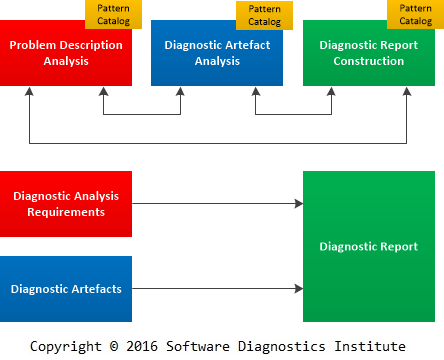
Software Diagnostic Space as a General Graph of Software Narratives
By connecting various memory spaces (user, kernel, physical, virtual, orbifold, manifold, fiber bundle, adjoint), trace and log spaces, and problem description narratives we introduce Software Diagnostics Space as a search space for finding problem patterns using general and concrete analysis patterns. Using mathematical metaphors we view it as a general graph of statements from Software Problem Narrative (graph vertices) and various software narratives such as logs, traces and memory spaces (edges). Software problem narratives may be different from software problem descriptions (which we get from software users and which have their own analysis patterns) because they are controlled narratives of actor interactions while working with software (top right corner of software narratology square). For completeness, every software narrative edge has vertices by default as start and stop vertices.
We consider Software Diagnostic Space as Trace Mask of Software Problem Narrative with Special and General Traces and Logs.
Let’s look at one example depicted in the following diagram:
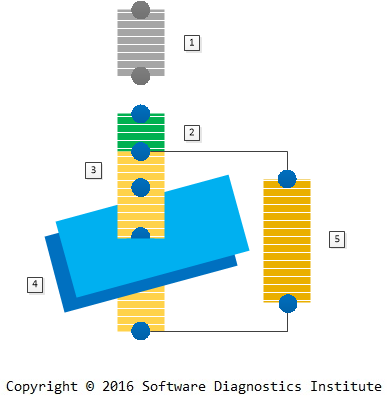
We have the problem description from a user who couldn’t exercise some software functionality unless some service was restarted. This is a problem description narrative (no. 1). A software support person constructed the problem reproduction setup narrative (no. 2) and recorded problem narrative no. 3 – 5 with tracing the client and server software and taking memory snapshots (Adjoint Space trace and log analysis pattern) of the corresponding service and another Coupled Process (memory analysis pattern).
This can all be depicted in the following general graph (multigraph) diagram where loops show adjoint spaces (“instantaneous” artifact snapshots like memory, data):
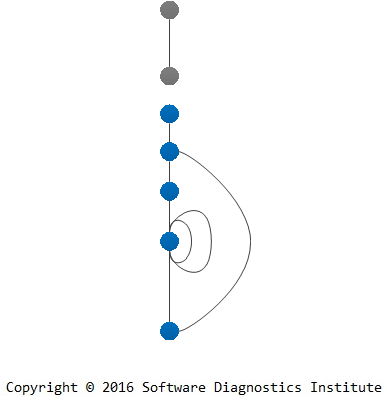
Such graphs may not be connected, and loops may be replaced by additional multiple edges with extra vertices.
The practical usage of such graphs can be demonstrated by their construction during problem analysis. Suppose that we have a problem description:

After its analysis we construct a problem narrative:
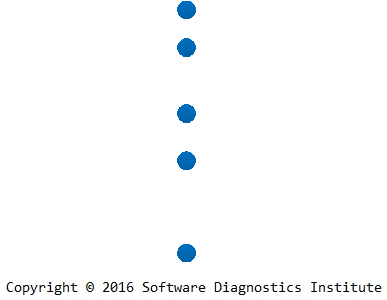
During its trace analysis we identify needed software trace edges:
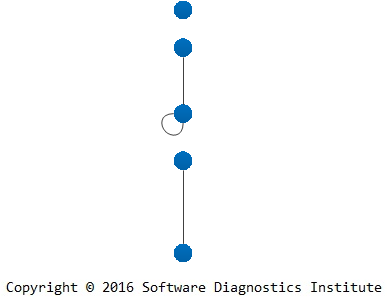
We add multiple edges if tracing involves several software systems or different trace varieties:
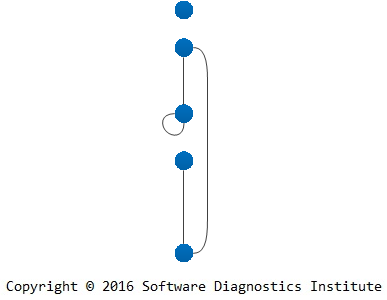
Topological Software Trace and Log Analysis
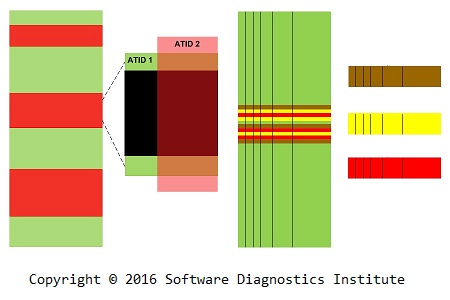
Previously we based software trace and log analysis on software narratology. While continuing further research and development in that direction we are now constructing a new software trace and log analysis system called TopoLog based on ideas and techniques from topology (originally called analysis situs in Latin: analysis of the situation) as a part of theoretical software diagnostics. Over the years we described a few trace and log analysis patterns based on topological metaphors: Quotient Trace, Message Cover, Fiber Bundle, Sheaf of Activities, and Adjoint Space. Before starting our pattern work on software trace analysis we considered threads as braids in abstract space, and, after the first analysis patterns, we considered multithreading as multibraiding. For general software traces and logs including memory snapshots we propose topological state analysis, for example, analysis of the covering space via open and closed Memory Regions and Region Strata.
Memory Dump Analysis Anthology, Volume 9b
The following direct links can be used to order the book now:
Buy Paperback or Kindle from Amazon
Buy Paperback from Barnes & Noble
Buy Paperback from Book Depository
Also available in PDF format from Software Diagnostics Services
Contains revised, edited, cross-referenced, and thematically organized selected articles from Software Diagnostics Institute (DumpAnalysis.org + TraceAnalysis.org) and Software Diagnostics Library (former Crash Dump Analysis blog, DumpAnalysis.org/blog) about software diagnostics, root cause analysis, debugging, crash and hang dump analysis, software trace and log analysis written in March - September 2016 for software engineers developing and maintaining products on Windows platforms, quality assurance engineers testing software, technical support and escalation engineers dealing with complex software issues, security researchers, reverse engineers, malware and memory forensics analysts. This volume is fully cross-referenced with volumes 1 – 9a and features:
- 11 new crash dump analysis patterns
- 11 new software log and trace analysis patterns
- New structural memory pattern
- Introduction to Riemann root cause analysis language
- Introduction to problem solving as code
- Introduction to Dia|gram graphical diagnostic analysis language
- Introduction to iterative pattern-oriented root cause analysis
- Definition of theoretical software diagnostics
Product information:
- Title: Memory Dump Analysis Anthology, Volume 9b
- Authors: Dmitry Vostokov, Software Diagnostics Institute
- Language: English
- Product Dimensions: 22.86 x 15.24
- Paperback: 149 pages
- Publisher: OpenTask (October 2016)
- ISBN-13: 978-1-908043-36-8
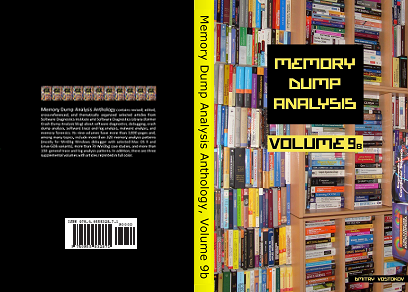
Theoretical Software Diagnostics and Education
After writing so much about software diagnostics, we introduce its abstract generalising principles of pattern orientation and systems thinking as Theory of Software Diagnostics. We were thinking about the importance of theory for quite some time until we got acquainted with the work of Leo Klejn who coined a term “theoretical archaeology.” Then we also decided to coin the similar term for software meta-diagnostics since we compiled two books as guides to software diagnostics principles irrespective of software platforms, vendors, and their software products: Software Diagnostics and Principles of Memory Dump Analysis and plan to publish a compilation of related theoretical articles (Theoretical Software Diagnostics, ISBN-13: 978-1-908043-98-6, forthcoming September 2016). Looking for the development of theoretical archaeology as guidance makes sense because it emerged recently in contemporary times and also deals with artefacts, historical reconstruction, and time- and memory-related issues, albeit of a different nature. While working on theoretical foundations and principles for many years, we had to learn theories, ideas, and metaphors of other disciplines used in software diagnostics that we call software para-diagnostic theories by analogy with para-archaeological (coined by Klejn) theories such as history, sociology, linguistics. In his book Introduction to Theoretical Archaeology: Meta-archaeology, Klejn made a few remarks on the required theoretical education. We would like to reformulate them in relation to theoretical software diagnostics:
- Very few people do theory because theoretical thinking requires broad education and polymath knowledge across many disciplines. We found that:
- Computer science and software engineering education helps in the practical side of software diagnostics but is not enough;
- Knowledge of university-level mathematics and natural science education help in understanding of technical diagnostics but is not enough;
- Knowledge of the principles of medical diagnostics helps because pattern-oriented facet of theoretical software diagnostics is partially based on medical metaphors;
- Knowledge of semiotics helps in understanding of the role of signs in theoretical software diagnostics;
- Knowledge of philosophy helps in deeper understanding of foundational aspects of theoretical software diagnostics such as the nature of problems, their phenomenology, meaning, and understanding;
- Humanities education (analysis of human-made artefacts) is very important since software diagnostics is also based on artefact analysis.
- Such education is needed from earlier up and in addition to computers and coding should also include history, philology, narratology, and literary theory.
- In summary, broad reading is required to get acquainted with diagnostics expertise in various domains of human activity.
Iterative Pattern-Oriented Root Cause Analysis
When we introduced A.P.M. patterns-based root cause analysis methodology (Artefacts. Patterns. Mechanisms.), it may have made an impression of a waterfall-type process with some iterations between artefact collection and diagnostic analysis when collected artefacts are not good. However, software post-construction problem solving is usually iterative, with memory dumps and software logs collected again and again after the preliminary root cause analysis.
To illustrate the iterative nature of the process we first name its stages as Artefact Acquisition for Artefacts, Artefact Analysis for Patterns (diagnostics), and Analysis of Analysis for Mechanisms (root cause analysis):
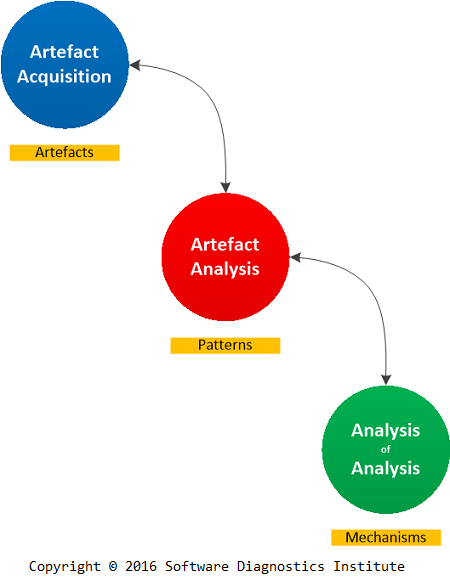
Now we rearrange these AA stages:
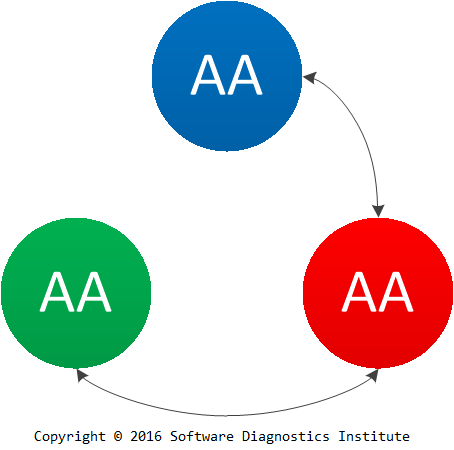
After the preliminary root cause analysis (Analysis of Analysis) we may need to gather more artefacts for further diagnostics and more precise RCA, and this is reflected in more focused stages:
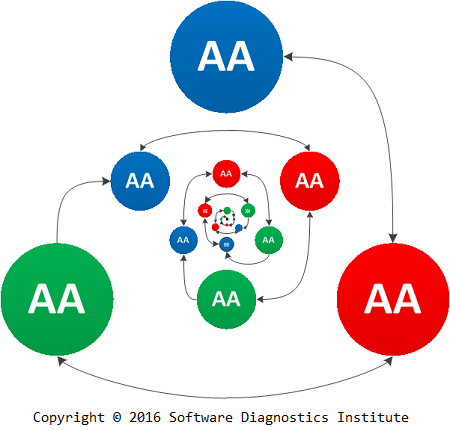
Problem Solving as Code
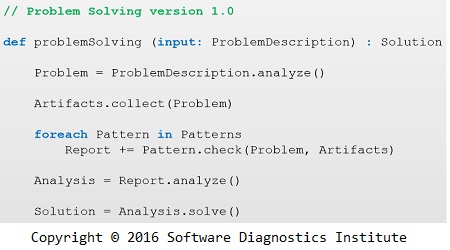
We introduce Problem Solving as Code as a process of developing, managing, and provisioning problem-solving methods and tools. Some problem-solving methodologies such pattern-oriented problem solving developed by Software Diagnostics Institute as a part of Diagnostics Science require constantly evolving pattern catalogues which can be stored in version control systems. For example, pattern-oriented software problem solving involves pattern-oriented problem description analysis and software execution memory and trace artefact acquisition, pattern-driven and pattern-based software diagnostics (including
Dia|gram Graphical Diagnostic Analysis Language

One of the current Software Diagnostics Institute projects is the development of Dia|gram graphical language for pattern-oriented software diagnostics, forensics, prognostics, root cause analysis and debugging. It combines the best features from:
- Visual Dump Objects: Graphical Notation for Memory Dumps;
- STDiagrams: Software Trace Diagrams;
- Visual compression of software traces and logs (including “bird’s eye view” of software traces), first introduced in Characteristic Message Block trace and log analysis pattern;
- Minimal Trace Graphs, first introduced in Activity Region trace and log analysis pattern. Numerous examples can be found in Accelerated Windows Software Trace Analysis training course reference and Software Trace and Log Analysis: A Pattern Reference book;
- Minimal Stack Trace Diagrams, first introduced in Constant Subtrace memory analysis pattern.
The purpose of Dia|gram language is twofold:
- To provide a succinct presentation and visualization of software execution state, artefacts, distribution of problem patterns, problem analysis patterns and their relationship;
- To communicate pattern-oriented software diagnostic analysis results.
Additionally, Dia|gram may be used for presentation and analysis of higher-order pattern narratives.
Software Diagnostics Institute also proposes the UML profile for Software Diagnostics with additional diagram types: artefact acquisition map, activity backtrace, and implementation internals. This work is only started, and more will be presented in subsequent articles.
Software Diagnostics Services plans to include Dia|gram in its forthcoming Advanced Software Trace and Log Analysis training course.
Riemann Root Cause Analysis Pattern Language

Image generated by 3D-XplorMath
Incepted and named in February 2009 shortly before the first software trace and log analysis pattern was published in April the same year, Riemann Programming Language was thought of as a software problem description language capable of generating software problem-solving tools (including TaaS version). A book was planned for publication in 2010: The Riemann Programming Language (ISBN: 978-1906717605). The main motivation at that time for the name was the metaphorical correspondence between multi-valued functions represented by Riemann surfaces and software defects as alternative branches of computation. Since the significant development of pattern-oriented software diagnostics, introduction of network and performance analysis pattern languages and patterns-based root cause analysis methodology we now make Riemann Programming Language an optional coding complement to Riemann Root Cause Analysis Pattern Language. The latter includes diagnostic analysis pattern languages for trace analysis and memory analysis developed by Software Diagnostics Institute including structural memory patterns in the context of general log analysis. We can now consider another analogy with multi-valued functions where the same general diagnostic patterns in a memory dump or log can be generated by different source code. Riemann RCA Pattern Language facilitates the transformation of software narrative artefacts into much shorter analysis narratives through the process of articoding. The resulting analysis artefacts can be programmatically processed to generate diagnostic, troubleshooting and debugging configurations, classes and functions, frameworks and plugins, components and nodes. The following diagram describes this process:

The Riemann programming language should not be confused with Riemann monitoring system which was named and developed later elsewhere by a different group of people and which is about collecting events and not about their collective analysis using pattern-oriented analysis methodology developed by Software Diagnostics Institute. Regarding event monitoring, Software Diagnostics Institute also develops platform-independent software trace and log acquisition patterns for better use of various monitoring systems.
Diagnostics of Things (DoT)

We introduced Narratology of Things as a combination of Software Narratology of Things and Hardware Narratology. Since memory dump analysis may be considered as a part of general trace and log analysis we open a new research direction for Diagnostics of Things (DoT) based on Narratology of Things and Pattern-Oriented Trace and Log Analysis, which also includes software execution artifacts of things and pattern-oriented network trace analysis from IoT.
Memory Dump Analysis Anthology, Volume 9a
The following direct links can be used to order the book now:
Buy Kindle version
Buy Paperback from Amazon
Buy Paperback from Barnes & Noble
Buy Paperback from Book Depository
Also available in PDF format from Software Diagnostics Services
Contains revised, edited, cross-referenced, and thematically organized selected articles from Software Diagnostics Institute (DumpAnalysis.org + TraceAnalysis.org) and Software Diagnostics Library (former Crash Dump Analysis blog, DumpAnalysis.org/blog) about software diagnostics, root cause analysis, debugging, crash and hang dump analysis, software trace and log analysis written in August 2015 - February 2016 for software engineers developing and maintaining products on Windows platforms, quality assurance engineers testing software, technical support and escalation engineers dealing with complex software issues, security researchers, reverse engineers, malware and memory forensics analysts. This volume is fully cross-referenced with volumes 1 – 8 and features:
- 9 new crash dump analysis patterns
- 9 new software log and trace analysis patterns
- 15 Linux core dump analysis pattern variants
- New workaround pattern
- New memory dump analysis case study
- Introduction to pattern-oriented software internals, pattern paradigms, pattern stacks, pattern repertoire
- Introduction to software diagnostics canvas
- Introduction to patterns-based root cause analysis methodology
- Introduction to a protein metaphor for software traces and logs
- Definition of software diagnostics scope
- Introduction to artificial debugger and pseudo-memory dumps
- Definition of tool-centric and pattern-centric software diagnostics, forensics, prognostics
Product information:
- Title: Memory Dump Analysis Anthology, Volume 9a
- Authors: Dmitry Vostokov, Software Diagnostics Institute
- Language: English
- Product Dimensions: 22.86 x 15.24
- Paperback: 179 pages
- Publisher: OpenTask (February 2016)
- ISBN-13: 978-1-908043-35-1

The Scope of Software Diagnostics
Should software diagnostics stand alone as a separate, distinct diagnostics or be a part of some other diagnostics? We considered initially 3 types of diagnostics: medical, technical, and software:
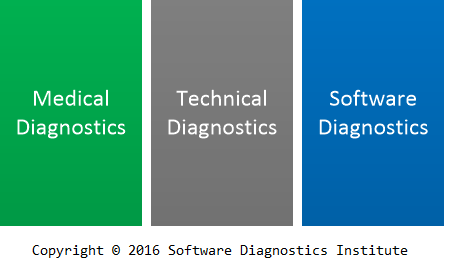
The objects of medical diagnostics are obviously humans and mostly their biological artefacts (we say mostly because linguistic and textual artifacts can also be used for diagnosis). The objects of technical diagnostics are structures and systems made from natural and artificial organic and inorganic engineering materials (Handbook of Technical Diagnostics: Fundamentals and Application to Structures and Systems, ISBN: 978-3642258497, pp. 11 – 16). The objects of software diagnostics are obviously software systems.
We define software diagnostics as “a discipline studying abnormal software structure and behavior in software execution artefacts (such as memory dumps, software and network traces and logs)” (Introduction to Philosophy of Software Diagnostics, Part 1, page 7) or, more generally, to include the context of forensics as “a discipline studying signs of software structure and behavior in software execution artefacts (such as memory dumps, software and network traces and logs)” (Pattern-Oriented Software Forensics: A Foundation of Memory Forensics and Forensics of Things, page 18).
Although, there are many conceptual similarities in general between these diagnostics, there are three features of software that set software diagnostics apart:
- A software system or its artefact can be copied.
- The software can be its own model. This follows from the previous feature since we can copy the software execution state and then study the effects of its execution independently. However, it is possible to have different software models for diagnostics as, for example, in Projective Debugging.
- Software execution artefacts are both symbolic and digital.
There are also humanistic artefacts (A New History of the Humanities: The Search for Principles and Patterns from Antiquity to the Present, ISBN: 978-0199665211) such text (including historical documents), language, literature, and music which are symbolic and digital or can be digitised. Diagnostics takes the form of literary criticism and text reconstruction (philology). Many similarities there gave rise to Software Narratology and Systemic Software Diagnostics:
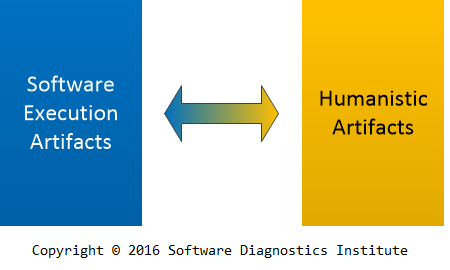
Teaching Complex Diagnostic Scenarios with Artificial Debugger (ArtDbg) and Pseudo-Memory Dumps
One of the problems in teaching software diagnostics and postmortem debugging is a simulation of complex software problem scenarios. There are plenty of real life memory dumps available but due to security considerations they cannot be shared outside of the organisation. Here we introduce Artificial Debugger project (ArtDbg) that simulates the I/O of the real debugger, for example, WinDbg, GDB, or LLDB.
The real memory dump is analyzed in the real debugger, and all debugger input and output is saved in a log file. This log file is then scanned for any potentially sensitive information, and all such information is eliminated (Security Problem, Memory Dump Analysis Anthology, Volume 1, page 224). It is then converted into a binary pseudo-memory dump format.
ArtDbg is used to open and analyze such pseudo-memory dumps. It allows using the same real debugger commands that were used to generate the log file. Such commands will output the same information that was available from the real debugger. Some real debugger commands that were not used to generate the log file may also be used if possible.
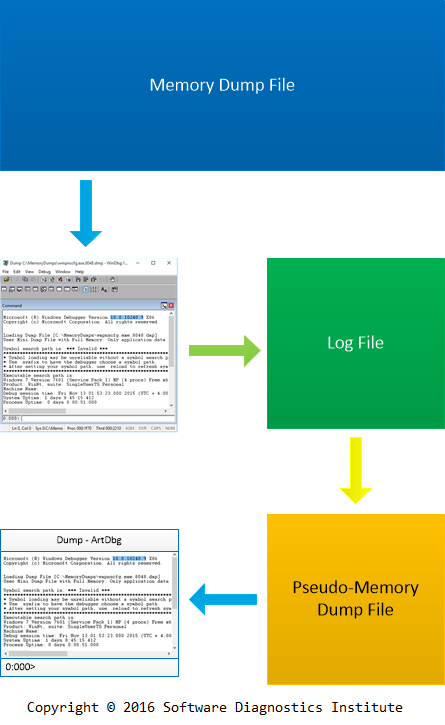
Software Diagnostics Services plans to use the first version of ArtDbg in their new version of Accelerated Windows Memory Dump Analysis training scheduled in March 2016 to teach some very complex enterprise diagnostic scenarios in addition to WinDbg exercises with real memory dumps.
Patterns-Based Root Cause Analysis Methodology
In 2011, we introduced iterative and incremental A.C.P. root cause analysis methodology. Its name is an abbreviation from the three main constituents: artifacts, checklists, and patterns. We get software execution artifacts such as memory dumps and software logs, use checklists to guide us in our problem analysis efforts, recognize patterns of abnormal software structure and behavior, and ultimately find out root cause(s). Recognized patterns may prompt us to revisit checklists for further guidance and request more software execution artifacts. The process is illustrated in the following diagram:
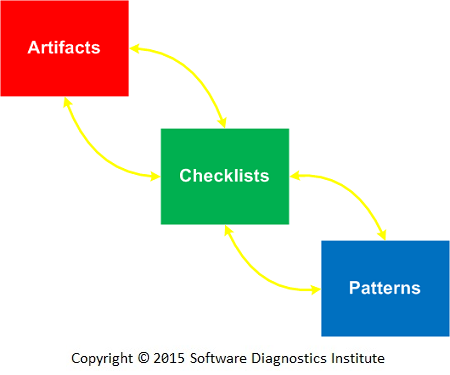
At that time, pattern-oriented software diagnostics was not yet fully developed so the proposed root cause analysis methodology was primarily debugger commands-based for memory analysis (in the form of checklists) and analysis patterns-based for software trace and log analysis where checklists were patterns-based. Pattern sequences (former pattern succession) help in finding root causes.
Pattern catalogues as checklists were later introduced for First Time Software Diagnosis methodology. Patterns were also introduced for memory dump and trace collection.
With the development of pattern-oriented software diagnostics, we realized the centrality of patterns and the division of patterns into general and concrete problem patterns and problem analysis patterns.
This brought the revision of A.C.P methodology where checklists become attributes of artifact collection and pattern catalogues:
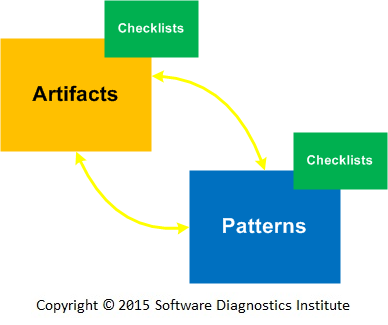
However, the causal nation of root cause analysis is not explicitly mentioned in the process. Many problem patterns can be caused differently, for example, Dynamic Memory Corruption patterns can be caused by buffer overwrites and underwrites, invalid API parameters, double memory releases, and even memory manager defects resulting in similar diagnostic indicators seen in memory snapshots and traces.
Therefore, we introduce the notion of Mechanism to describe the possible cause of a diagnostic pattern. Such mechanisms replace pattern sequences as causal analysis tools. Mechanisms can also be organized into catalogues and have checklists. Mechanisms provide software internal links between software construction, post-construction, and deconstruction pattern paradigms.
The resulting iterative and incremental A.P.M. methodology (Artifacts. Patterns. Mechanisms.) is illustrated in the following diagram:
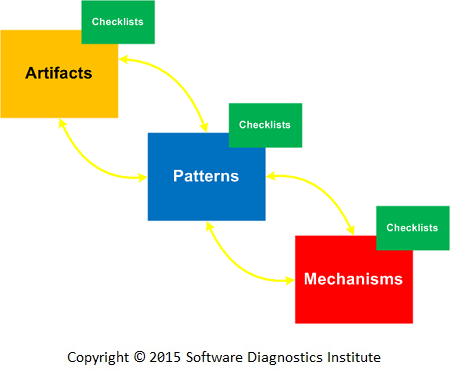
The forthcoming volumes of Memory Dump Analysis Anthology (from volume 9) will now include Software Problem Mechanisms and Pattern-Oriented Root Cause Analysis Case Studies chapters in addition to usual pattern chapters.
Software Traces and Logs as Proteins
In the past, we introduced structural and behavioral memory and software trace analysis patterns as DNA of software behavior. This metaphor can be illustrated in the following diagram:
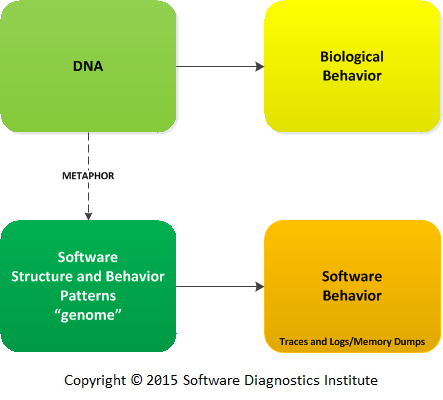
Now, we introduce another metaphor: software traces and logs are “proteins” generated by software code. Such “proteins” are mapped to software functionality:
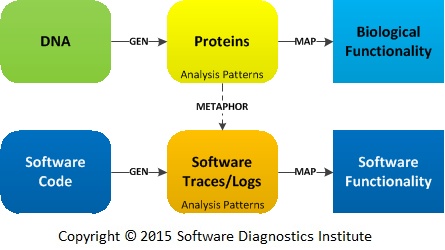
There are many similarities between protein structural analysis and that of traces and logs. For example, sequence motifs are analogous to Motif trace analysis pattern (that originally came from motives in mathematics), and structural motifs are possible via Characteristic Message Blocks and Activity Regions or any other arrangement of structural patterns:
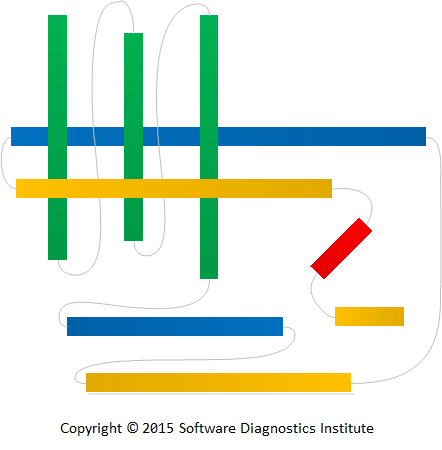
Software Diagnostics Canvas
We introduce canvas for pattern-oriented software diagnostics process to facilitate better diagnostic analysis reports. A piece of paper is divided into 3 columns: Input, Analysis, and Output.
The Input column is divided into two sections: Problem Description Patterns and DA+TA Collection Patterns. Problem Description pattern catalog was introduced earlier in Volume 7 of Memory Dump Analysis Anthology to help with accurate software problem identification. DA+TA Collection pattern catalogs for dump artifacts (DA) and trace artifacts (TA) were also introduced in Volume 7 as Memory Acquisition and Trace Acquisition pattern catalogs.
The Analysis column is divided into two sections: Analysis Patterns and Problem Patterns. The former are about diagnostic analysis techniques, and the latter are about diagnosed software problems. The distinction between them was introduced in Volume 8b. All such patterns can be found in Memory Analysis pattern catalog and Trace and Log Analysis pattern catalog .
The Output column is also divided into two sections: Analysis Report Patterns and Recommended Action Patterns. The corresponding pattern catalogs are under development. The former is about patterns for useful and meaningful diagnostic analysis reports, and the latter is about the good workaround, troubleshooting, and debugging recommendations.
Each cell is subdivided into General and Concrete patterns where the latter are specific product patterns such as a memory access violation in a specific module.
The first version of the canvas template can be downloaded from here.
Pattern-Oriented Software Internals: Pattern Paradigms and Software Internals Pattern Stack
By software internals, we mean how software actually works instead of how it was intended to work. Intention and actuality may also coincide, but, sometimes, they don’t, especially in the cases of victimware and malware, and their discrepancy, therefore, cause various problems. Learning software internals, especially operating system internals, is a necessary step towards better software construction, effective and efficient troubleshooting and debugging, successful forensics, malware and vulnerability research.
There are different approaches to teaching software internals of operating systems and products. Some authors prefer computer science approach from general software design and architecture principles; some prefer software hands-on troubleshooting approach such as troubleshooting and debugging; some prefer reversing and deconstructive approach. Learners of different backgrounds may find particular approaches difficult to internalize. Here we refer to our own experience learning operating system internals when our main background was in software design, programming, and debugging (before we moved to software support to study software diagnostics).
We think that the ideal way would be to cover all aspects of software construction and post-construction using patterns. However, different phases of software evolution use different pattern paradigms. Software construction phase mainly uses software construction pattern stack of requirements analysis, architecture, design, and implementation patterns which are patterns of software construction problem solving. Software construction pattern paradigm considers patterns as solutions to recurrent problems of building software. Software post-construction phase mainly uses diagnostic patterns and debugging pattern stack [Analysis, Architectural, Design, Implementation and Usage Debugging Patterns, Memory Dump Analysis Anthology, Volumes 6 - 7]. Diagnostic pattern paradigm considers patterns as indicators of software behavior such as signals, symptoms, and signs describing software execution problems. Debugging patterns are similar to software construction patterns in documenting common recurrent problems of fixing software defects. They provide solutions to recurrent debugging problems. Similar can be said about problem workaround patterns and patterns of building software troubleshooting and debugging tools (Debugware patterns [Memory Dump Analysis Anthology, Volumes 2, 4, 6]). There is also a third pattern paradigm: software deconstruction patterns including reversing (ADDR patterns) and structural memory patterns [Memory Dump Analysis Anthology, Volume 5]. This paradigm just shows how things are really are organized before and during software execution including software / hardware interface.
In summary, we have three pattern paradigms corresponding to the domain of construction, post-construction, and deconstruction.
All three pattern paradigms are needed to describe software internals, its architecture, implementation, inner workings, and problem-solving. Instead of devising a new set of patterns to describe software internals we propose a pattern stack of existent patterns. In its rough and simple form it consists of 3 stack slots corresponding to 3 pattern paradigms:
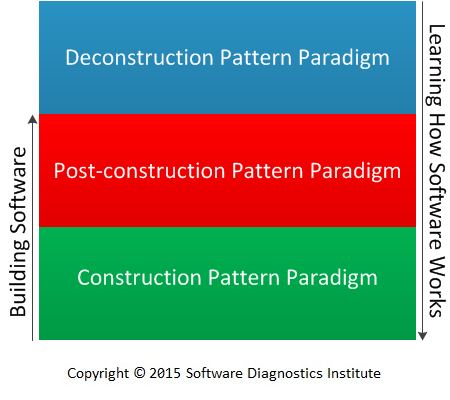
Each pattern paradigm can be expanded into its own substack or a collection (when order is not important) of pattern categories:
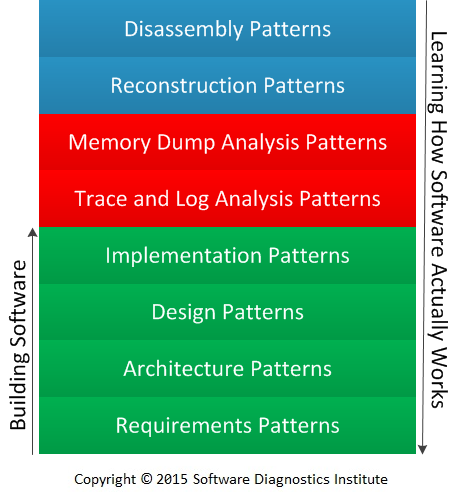
Individual software internal features can be described by a concrete pattern stack of patterns from pattern category subcatalogs, for example, software fault processing pattern stack (only a few important conceptual patterns and pattern subcatalogs are listed):
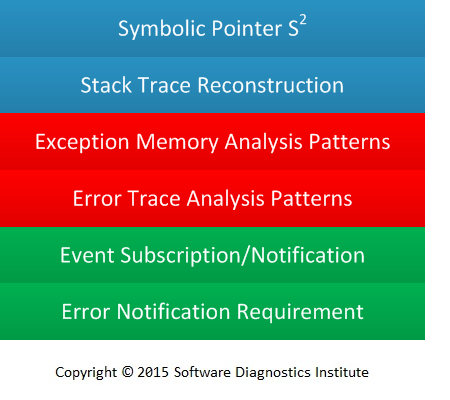
We believe that teaching software internals, for example, operating system internals, using a pattern stack approach would appeal to all types of learners: software architects, software developers, software support engineers, and software security researchers.
World Software Diagnostics Day
We propose August 14 as the World Software Diagnostics Day. The rationale behind this chosen date:
- 0n14 is 0xE(rror)
- August is the 7th month based on 0-numbering scheme, and 7 is the number usually identified with user space
- August is the 8th month based on 1-numbering scheme, and 8 is the number usually identified with kernel space
- The first entry in Software Diagnostics Library was written on August 14, 2006 (Crash Dump Analysis blog at that time)
- In 2016 we celebrate 10 years of DumpAnalysis.org which in 2006 laid the foundations of pattern-oriented software diagnostics (now, together with TraceAnalysis.org, Software Diagnostics Institute), and, therefore, the first World Software Diagnostics Day will be celebrated in 2016
Authorized Training Providers
Software Diagnostics Institute, the founder of Pattern-Oriented Software Diagnostics, Forensics, Prognostics, appoints Software Diagnostics Services as the authorized training provider to teach pattern-oriented software diagnostics and the following associated subfields based on pattern-oriented software diagnostics methodology:
- Pattern-oriented memory dump analysis
- Pattern-oriented memory forensics
- Pattern-oriented network forensics
- Pattern-oriented software trace and log analysis
- Pattern-oriented network trace analysis
- Pattern-oriented malware analysis
- Pattern-oriented vulnerability analysis
- Pattern-oriented reverse engineering
- Pattern-oriented software forensics
- Pattern-oriented software prognostics
- Pattern-oriented software performance analysis
- Pattern-oriented observability
- Pattern-oriented debugging process
- Pattern-oriented software execution artifact collection
- Pattern-oriented static code analysis
- Pattern-oriented software internals
- Pattern-oriented root cause analysis
- Pattern-oriented diagnostic analysis
- Pattern-oriented problem solving
The list of seminars introducing and explaining pattern-oriented software diagnostics: http://www.patterndiagnostics.com/reference-materials
The list of training courses and reference materials is available on Software Diagnostics Services website.
Pattern Repertoire
When developing, debugging, maintaining, and supporting software it is important to have knowledge of general problem analysis patterns of abnormal software structure and behavior. As with any language, such a pattern language comes in passive and active usage variants. A passive pattern user knows about a particular analysis pattern but may have difficulty recognizing it in a specific software execution artifact such as a memory dump or log. A passive user may become an active user after training and experience. “Pattern Repertoire” is such user knowledge (or awareness) of a specific set of patterns from pattern catalogues (see the definition of repertoire). An active pattern repertoire of a Windows software engineer first becomes passive when the engineer starts working with Linux, Mac OS X, Android, iOS, z/OS, or any other platform but then becomes active through experience. In any case, the possession of a pattern repertoire and its size (the pattern language vocabulary) is an important asset. What distinguishes the pattern repertoire from a mere set of pattern names is the knowledge of its syntax (analysis pattern combinations), semantics (the meaning of analysis patterns), and pragmatics (active usage in concrete situations and passive knowledge of usage in general situations). Similar to software construction pattern repertoire which helps with software construction problem analysis, architecture, design, and implementation, software post-construction pattern repertoire helps to perform software post-construction problem diagnostic analysis and debugging more efficiently and effectively. A few words must be said about implicit pattern knowledge. Some patterns may be obvious and used unconsciously. However, their explicit naming helps with communicating analysis decisions, troubleshooting and debugging recommendations, and creating problem-solving case studies.
Here, we would like to show the building of our diagnostic analysis pattern repertoire for memory dumps, software traces, and logs. The following picture illustrates the growth of the number of software diagnostic analysis patterns with each successive volume of Memory Dump Analysis Anthology (excluding malware analysis patterns published in Volume 7, and structural memory patterns published in Volume 5):
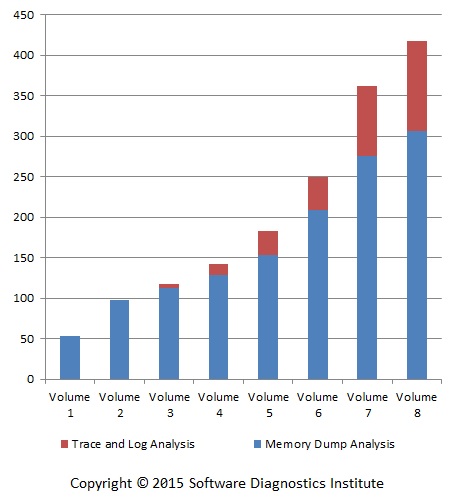
The picture shows, for example, that volumes 6 – 8 introduced more analysis patterns than volumes 1 – 5. Volumes 7 and 8 alone introduced 63% of the current trace and log analysis patterns, and 32% of the current crash and hang memory dump analysis patterns.
Memory Dump Analysis Anthology, Volume 8b
The following direct links can be used to order the book now:
Buy Kindle version
Buy Paperback from Amazon
Buy Paperback from Barnes & Noble
Buy Paperback from Book Depository
Also available in PDF format from Software Diagnostics Services
Contains revised, edited, cross-referenced, and thematically organized selected articles from Software Diagnostics Institute (DumpAnalysis.org + TraceAnalysis.org) and Software Diagnostics Library (former Crash Dump Analysis blog, DumpAnalysis.org/blog) about software diagnostics, debugging, crash dump analysis, memory forensics, software trace and log analysis written in December 2014 - July 2015 for software engineers developing and maintaining products on Windows platforms, quality assurance engineers testing software, technical support and escalation engineers dealing with complex software issues, security researchers, reverse engineers, malware and memory forensics analysts. This volume is fully cross-referenced with volumes 1 – 7, 8a, and features:
- 12 new crash dump analysis patterns
- 15 new software log and trace analysis patterns
- New memory dump analysis case study
- Introduction to articoding
- Introduction to special and general trace and log analysis
- Introduction to projective debugging
- Introduction to artifact-malware
- Introduction to concrete and general problem analysis patterns
Product information:
- Title: Memory Dump Analysis Anthology, Volume 8b
- Authors: Dmitry Vostokov, Software Diagnostics Institute
- Language: English
- Product Dimensions: 22.86 x 15.24
- Paperback: 169 pages
- Publisher: OpenTask (July 2015)
- ISBN-13: 978-1-908043-54-2
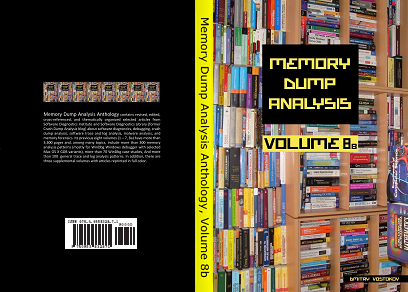
Pattern! What Pattern?
There is confusion about patterns of diagnostics such as related to crash dump analysis and software trace and log analysis. We are often asked about pattern percentage detection rate or whether it is possible to automate pattern diagnostics. Before asking and answering such questions, it is important to understand what kinds of patterns are meant. Patterns of diagnostics can be subdivided into concrete and general problem patterns, and, also, into concrete and general analysis patterns.
Problem patterns are simply diagnostic patterns, and they can be defined as (fusing Diagnostic Pattern1 and Diagnostic Problem2 definitions):
A common recurrent identifiable set of indicators (signs) together with a set of recommendations and possible solutions to apply in a specific context.
Concrete Problem Patterns are particular sets of indicators, for example, an exception stack trace showing an invalid memory access in the particular function from the particular component/module code loaded and executed on Windows platform.
But such indicators can be generalized from different products and OS platforms giving rise to General Problem Patterns forming a pattern language. Our previous example can be generalized as Exception Stack Trace showing Invalid Pointer and Exception Module. Concrete Problem Patterns are the implementation of the corresponding General Problem Patterns.
Now, it becomes clear why Memory Analysis Pattern Catalog doesn’t have any concrete BSOD bugcheck numbers. Most of such numbers are concrete implementations of Self-Diagnosis pattern.
Then we have Concrete Analysis Patterns as particular techniques to uncover Concrete Problem Patterns. For example, thread raw stack analysis for historical information to reconstruct a stack trace. Again, such techniques vary between OS platform and even between debuggers.
Generalizing again, we have General Analysis Patterns, for example, analyzing Historical Information in Execution Residue to construct Glued Stack Trace.
General Problem Pattern descriptions may already reference General Analysis Patterns, and in some cases both may coincide. For example, Hidden Exception pattern uses Execution Residue pattern as a technique to uncover such exceptions.
Most of Software Trace and Log Analysis Patterns are General Analysis Patterns that were devised and cataloged to structure the analysis of the diverse logs from different products and OS platforms3. For example, a specific data value common to both working and problem logs that helps to find out the missing information from the problem description can be generalized to Inter-Correlation analysis between the problem trace and Master Trace using Shared Point.
This partitioning is depicted in the following diagram:
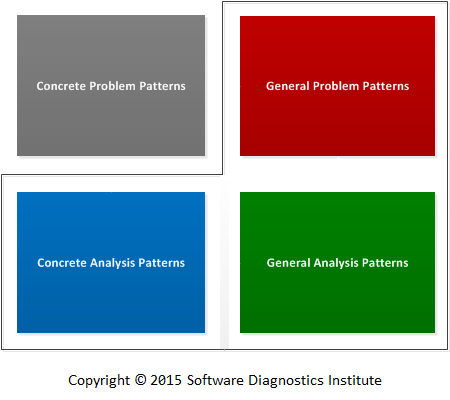
Software Diagnostics Institute innovation is in devising and cataloging general problem and analysis patterns and providing some concrete analysis implementations on specific OS platforms such as Windows and Mac OS X.
1 Pattern-Oriented Software Forensics: A Foundation of Memory Forensics and Forensics of Things, page 13
2 Ibid., page 14
3 Malware Narratives: An Introduction, page 14
Artifact-Malware and its Primary and Secondary Effects
A few days ago we saw an article in Facebook stream about trolling airline passengers. When they descend to an airport, they read a different city name written in large letters on the roof of some house.
An idea came to us to model this behavior for memory dump analysis: when we analyze crash dumps we usually rely on the output of some commands that redirect or reformat the contents of memory. For example, lmv WinDbg command shows module resource information such as its product name, copyright information, etc. What if that information were deliberately crafted to deceive and disturb software diagnostics and debugging process, and ultimately to explore possible vulnerabilities there? Popular debuggers have their own vulnerabilities1 which may be used not only for anti-debugging purposes. When we say “deliberately crafted” we don’t mean Fake Module2 malware analysis pattern that is about a module that tries to present itself as another legitimate, well-known module. Also, we are not concerned with false positive decoy artifacts3. In our case Artifact-Malware, as we call it (or Arti-Malware for short, not to confuse with anti-malware), intentionally leaves malicious legitimate artifacts in software execution artifacts (such as memory dumps, traces, and logs) deliberately structured to alter execution of static analysis tools such as debuggers, disassemblers, reversing tools, etc. Such artifacts in artifacts may suggest exploring them further as possible culprits of abnormal software behavior thus triggering certain software and human vulnerabilities, and even social engineering attacks (when they suggest calling a phone number).
To model this, we quickly created a small Visual C++ project called TrollingApp and inserted version info resource. Normally WinDbg lmv command would show something like this:
0:000> lmv m TrollingModule
start end module name
00000001`3ff50000 00000001`3ff58000 TrollingModule C
(private pdb symbols)
Loaded symbol image file: TrollingModule.exe
Image path: ...\TrollingApp\x64\Release\TrollingModule.exe
Image name: TrollingModule.exe
Timestamp: Sat Jun 27 10:28:47 2015 (558E6CCF)
CheckSum: 00000000
ImageSize: 00008000
File version: 1.0.0.1
Product version: 1.0.0.1
File flags: 0 (Mask 3F)
File OS: 40004 NT Win32
File type: 1.0 App
File date: 00000000.00000000
Translations: 1809.04b0
CompanyName: TODO:
ProductName: TODO:
InternalName: TrollingModule.exe
OriginalFilename: TrollingModule.exe
ProductVersion: 1.0.0.1
FileVersion: 1.0.0.1
FileDescription: TODO:
LegalCopyright: Copyright © 2015
by Software Diagnostics Institute
Since LegalCopyright is the last field shown in the formatted output, we changed it to contain the long string of “\r\n” characters intended to scroll away module information. The string was long as it was allowed by the resource compiler.
VS_VERSION_INFO VERSIONINFO
FILEVERSION 1,0,0,1
PRODUCTVERSION 1,0,0,1
FILEFLAGSMASK 0x3fL
FILEFLAGS 0x0L
FILEOS 0x40004L
FILETYPE 0x1L
FILESUBTYPE 0x0L
BEGIN
BLOCK "StringFileInfo"
BEGIN
BLOCK "180904b0"
BEGIN
VALUE "CompanyName", "TODO: "
VALUE "FileDescription", "TODO: "
VALUE "FileVersion", "1.0.0.1"
VALUE "InternalName", "TrollingModule.exe"
VALUE "LegalCopyright", "\r\n\r\n\r\n ... "
VALUE "OriginalFilename", "TrollingModule.exe"
VALUE "ProductName", "TODO: "
VALUE "ProductVersion", "1.0.0.1"
END
END
BLOCK "VarFileInfo"
BEGIN
VALUE "Translation", 0x1809, 1200
END
END
The program itself is very simple triggering a NULL pointer exception to generate a crash dump (we configured LocalDumps registry key on Windows 7).
int _tmain(int argc, _TCHAR* argv[])
{
int *p = 0;
*p = 0;
return 0;
}
So we opened a crash dump and checked the stack trace which suggested checking information about TrollingModule (as Exception Module4 memory analysis pattern):
Loading Dump File [C:\MemoryDumps\TrollingModule.exe.2076.dmp]
User Mini Dump File with Full Memory: Only application data is available
Windows 7 Version 7601 (Service Pack 1) MP (4 procs) Free x64
Product: WinNt, suite: SingleUserTS Personal
Machine Name:
Debug session time: Sat Jun 27 10:28:58.000 2015 (UTC + 1:00)
System Uptime: 3 days 21:28:51.750
Process Uptime: 0 days 0:00:01.000
.....
This dump file has an exception of interest stored in it.
The stored exception information can be accessed via .ecxr.
(81c.1604): Access violation - code c0000005 (first/second chance not available)
ntdll!NtWaitForMultipleObjects+0xa:
00000000`7769186a c3 ret
0:000> .symfix c:\mss
0:000> .reload
.....
0:000> kL
Child-SP RetAddr Call Site
00000000`001fe6d8 000007fe`fd741430 ntdll!NtWaitForMultipleObjects+0xa
00000000`001fe6e0 00000000`77541723 KERNELBASE!WaitForMultipleObjectsEx+0xe8
00000000`001fe7e0 00000000`775bb5e5 kernel32!WaitForMultipleObjectsExImplementation+0xb3
00000000`001fe870 00000000`775bb767 kernel32!WerpReportFaultInternal+0x215
00000000`001fe910 00000000`775bb7bf kernel32!WerpReportFault+0x77
00000000`001fe940 00000000`775bb9dc kernel32!BasepReportFault+0x1f
00000000`001fe970 00000000`776d3398 kernel32!UnhandledExceptionFilter+0x1fc
00000000`001fea50 00000000`776585c8 ntdll! ?? ::FNODOBFM::`string'+0x2365
00000000`001fea80 00000000`77669d2d ntdll!_C_specific_handler+0x8c
00000000`001feaf0 00000000`776591cf ntdll!RtlpExecuteHandlerForException+0xd
00000000`001feb20 00000000`77691248 ntdll!RtlDispatchException+0x45a
00000000`001ff200 00000001`3ff51002 ntdll!KiUserExceptionDispatch+0x2e
00000000`001ff908 00000001`3ff51283 TrollingModule!wmain+0x2
00000000`001ff910 00000000`775359ed TrollingModule!__tmainCRTStartup+0x10f
00000000`001ff940 00000000`7766c541 kernel32!BaseThreadInitThunk+0xd
00000000`001ff970 00000000`00000000 ntdll!RtlUserThreadStart+0x1d
But when we executed lmv command we saw the blank screen with some UNICODE symbols at the end:
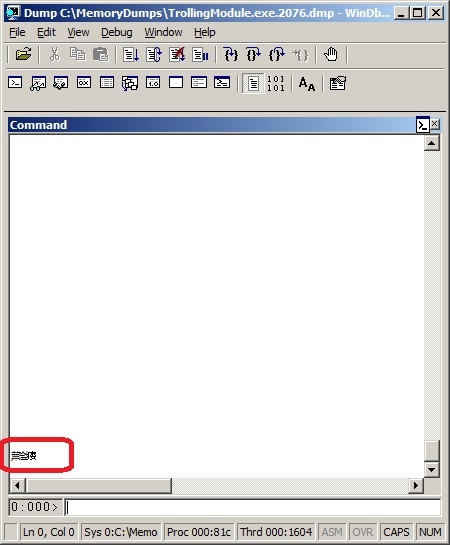
Not only we triggered the scroll but the artifact buffer somehow caused additional unintended consequences.
We were also surprised by the second order effects. We were curious about what that Unicode string was meant and copied it to Google translate page in IE. It was hanging afterward spiking CPU when we were switching to that tab. We tried to save a crash dump using Task Manager, but it failed with a message about an error in ReadProcessMemory API and, although, the crash dump was saved, it was corrupt. The tab was recovered, and we were not able to reproduce it again. Perhaps, the browser was already in an abnormal state because on the second attempt it behaved better:

Simple Google search shows that such output also appeared in different problems such as related to PDF printing:

In conclusion, we say that the primary effect of arti-malware is abnormal software behavior in static analysis tools. We have the secondary effect when information produced by a static analysis tool triggers abnormal software behavior in another analysis tool.
1 M. Sikorski, A. Honig, Practical Malware Analysis, Debugger Vulnerabilities, page 363
2 D. Vostokov, Memory Dump Analysis Anthology, Volume 7, page 240
3 A. Walters, N. Petroni, Jr., Volatools: Integrating Volatile Memory Forensics into the Digital Investigation Process
4 D. Vostokov, Memory Dump Analysis Anthology, Volume 8a, page 80
Coding and Articoding
The analysis of software traces and logs is largely a qualitative activity. We look for specific problem domain patterns using general analysis patterns (problem domain pattern hierarchy). Some methodological aspects of this software defect research are similar to qualitative research method in social sciences. The latter method uses the so-called coding techniques for data analysis. Software traces and debugger logs from memory dumps are software execution artifacts we previously called DA+TA (Dump Artifact + Trace Artifact, Memory Dump Analysis Anthology, Volume 3, page 330). We propose to use similar “coding” techniques to annotate them with diagnostic indicators, signal and sign mnemonics, and patterns (such as software diagnosis codes). We, therefore, call this software post-construction “coding” as articoding (artecoding), from artifact (artefact) + coding, to distinguish it from software construction coding. Such articoding forms a part of software post-construction problem solving (Introduction to Pattern-Driven Software Problem Solving, page 8). Articodes form a second order software narrative and can be articoded too.
Many software tools were developed for assisting qualitative research coding, and these can be reused for “coding” debugger logs, for example. In addition to those tools, general word and table processing programs can be used as well for some types of artifacts. Here we show MS Word for a WinDbg log example. The debugger log with stack traces from all processes and threads was loaded into MS Word template table with 3 columns. The first column is the log itself, the second column is for diagnostic indicators (such as critical section, CPU consumption, ALPC wait, etc.), and the third column is for pattern language articodes (here we use pattern names from Memory Analysis Pattern Catalog, for traces we can use MS Excel and Trace and Log Analysis Pattern Catalog):
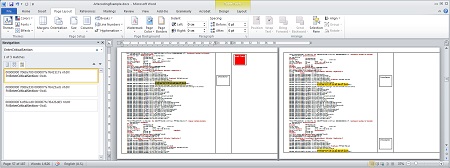
(Click to expand this screenshot)
Formatting and highlighting creativity here is unlimited. Irrelevant parts from the log can be deleted, and the final analysis log can have only relevant annotated tracing information.
Projective Debugging
Modern software systems and products are hard to debug despite their elaborate tracing and logging facilities. Typical logs may include millions of trace messages from hundreds and thousands of components, processes, and threads. The postmortem diagnostic analysis became more structural after the introduction of Trace and Log Analysis Patterns but live debugging requires a lot more efforts. Here we introduce Projective Debugging as a tool for trace-level debugging. Its main idea is to analyze, diagnose and debug the so-called “projected” execution of software as seen from the original software execution traces and logs:
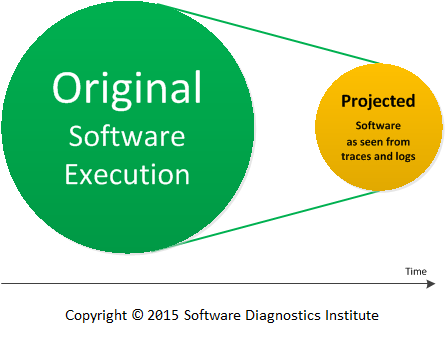
Picture 1. Original software execution is mapped into projected software as seen from traces and logs.
Please notice, that Projective Debugging is different from the so-called Prototype Debugging by creating models after the software product is built (some engineering methodologies prescribe that prototypes should be discarded before building the product):
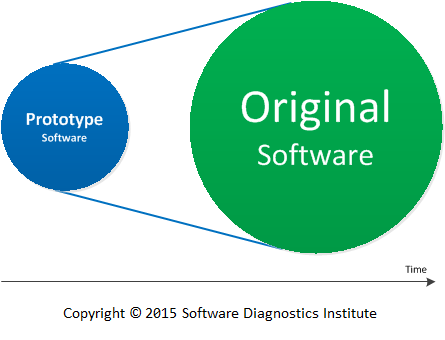
Picture 2. Prototype software is mapped into the product.
The problems diagnosed and solved in the projected system are fed back into the original system:
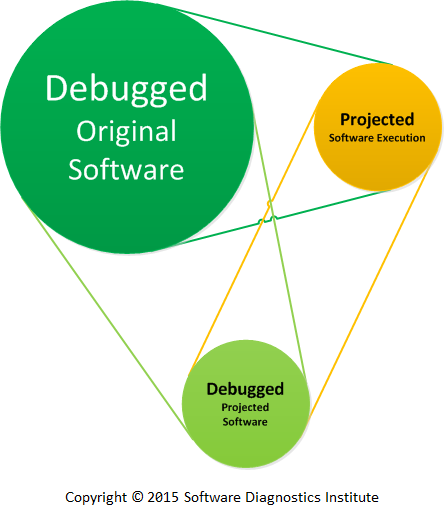
Picture 3. Debugged projected software is mapped into the original software.
The implementation of the main idea of Projective Debugging is that: we can take a trace or log, interpret every trace message according to some rules, and translate it into executable code mirroring components and execution entities such as user sessions, processes, and threads. This is a task for the Projective Debugger, and it is illustrated in the following diagram where we borrowed notation from UML:
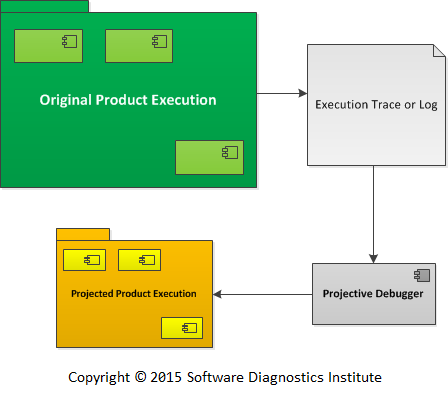
Picture 4. The logs and traces from the original product execution are translated by Projective Debugger.
For example, the Projective Debugger (ProjectiveDebugger.exe) interprets these very simple messages below, and creates a process PID220.exe (we have only one thread), and then opens a file “data.txt”. After 10 seconds, it closes the file.
Time PID TID Message ----------------------------------- 11:00:00 220 330 Open “data.txt” 11:00:10 220 330 Close “data.txt”
In addition to executing code corresponding to messages using the same time deltas as read from the trace, it may scale execution time proportionally, for example, executing 2-day log in a matter of minutes. Such scaling may also uncover additional synchronization bugs.
The trace may be pre-processed, and all necessary objects created before execution or it may be interpreted line by line. For complex traces, the projected source code may be generated for later compilation, linking, and execution. Once the projected code is executed, breakpoints may be set on existing traces, and other types of Debugging Implementation Patterns may be applied. Moreover, we may re-execute the trace several times and even have some limited form of backward execution.
The resulting code model can be inspected by native debuggers for the presence of Memory Analysis Patterns and can even have its own logging instrumentation with traces and logs analyzed by another instance of the Projective Debugger:
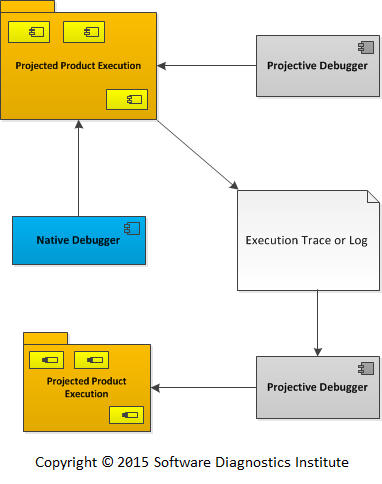
Picture 5. Projected Product Execution is inspected by a native debugger and also generates its own set of traces and logs to be projected to another model by another instance of the Projected Debugger.
We created the first version of the Projective Debugger and successfully applied to a small trace involving synchronization primitives across several threads. The Projective Debugger was able to translate it into an executable model with the same number of threads and the same synchronization primitives and logic. The resulting process was hung as expected and we attached a native debugger (WinDbg for Windows) and found a deadlock.
Since traces are analyzed from platform-independent Software Narratology perspective it is possible to get a trace from one operating system, and then, after applying a set of rules, re-interpret it into an executable model on another operating system. We created the similar multithreading test program on Mac OS X that was hung and reinterpreted its trace into an executable model under Windows:
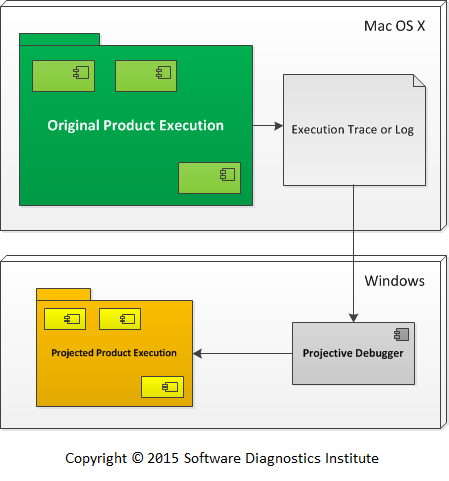
Picture 6. The traces and logs from the original product execution on Mac OS X are projected by a Windows version of Projective Debugger into an executable model for a Windows platform.
Since resultant executable models can also have corresponding logging instrumentation mirroring original tracing, any problems found in executable models can be fixed iteratively and, once the problem disappears, the resulting fix or configuration may be incorporated into the original product or system.
If tracing involves kernel space and mode, a specialized projected executable can be created to model the operating system and driver level.
The more tracing data you have, more real your projected execution becomes. However, we want to have enough tracing statements but not to complicate the projected model. Then, ideally, we should trace only relevant behavior, for example, corresponding to use cases and architecture.
Projective Debugging may also improve your system or product maintainability by highlighting whether you need more tracing statements and whether you need more accurate and complete tracing statements.
Memory Dump and Live Memory Visualization and Picture Extraction
NEW! The updated version of Dump2Picture is available: http://www.dumpanalysis.org/dump2picture
This is a reprint of several articles with permission from Memory Dump Analysis Anthology, Volume 1.
As the first step towards Memory Dump Tomography (Memory Dump Analysis Anthology, Volume 1, page 522) we created a small program that interprets a memory dump as a picture. We can visualize crash dumps with it. The tool is available for free download.
Simply run it from the command prompt and specify full paths to a dump file and an output BMP file. The memory dump file will be converted by default into true color, 32 bits-per-pixel bitmap. We can specify other values: 8, 16 and 24.
C:\Dump2Picture>Dump2Picture.exe
Dump2Picture version 1.0
Written by Dmitry Vostokov, 2007
Usage: Dump2Picture dumpfile bmpfile [8|16|24|32]
For example:
C:\Dump2Picture>Dump2Picture.exe MEMORY.DMP MEMORY.BMP 8
Dump2Picture version 1.0
Written by Dmitry Vostokov, 2007
MEMORY.BMP
MEMORY.DMP
1 file(s) copied.
Below are some screenshots of bitmap files created by the tool. We can think about them as visualized kernel or user address spaces.
Vista kernel memory dump (8 bits-per-pixel):

Vista kernel memory dump (16 bits-per-pixel):

Vista kernel memory dump (24 bits-per-pixel):

Vista kernel memory dump (32 bits-per-pixel):

Notepad process user memory dump (8 bits-per-pixel):

Notepad process user memory dump (16 bits-per-pixel):
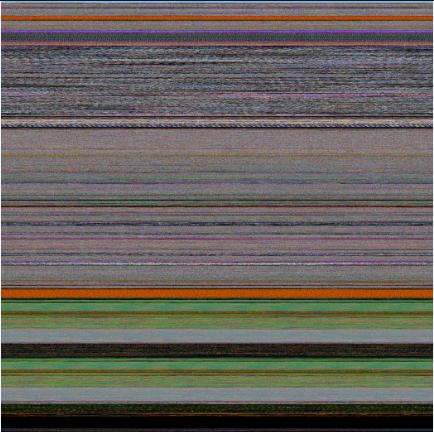
Notepad process user memory dump (24 bits-per-pixel):
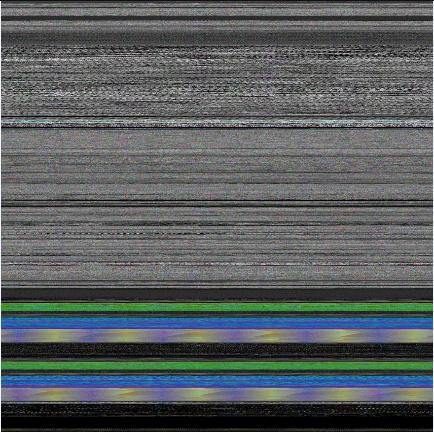
Notepad process user memory dump (32 bits-per-pixel):
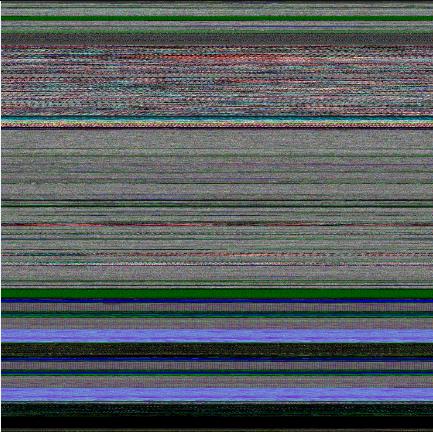
Mspaint process user memory dump (32 bits-per-pixel):
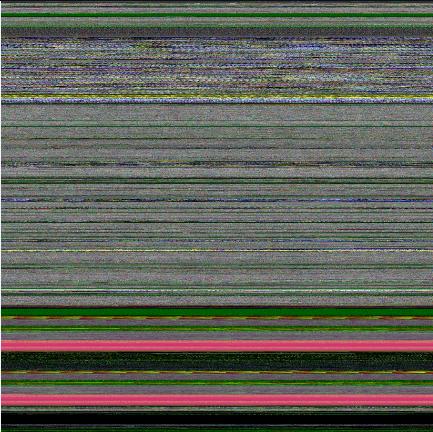
Mspaint process user memory dump after loading "Toco Toucan.jpg" from Vista Sample Pictures folder (32 bits-per-pixel):
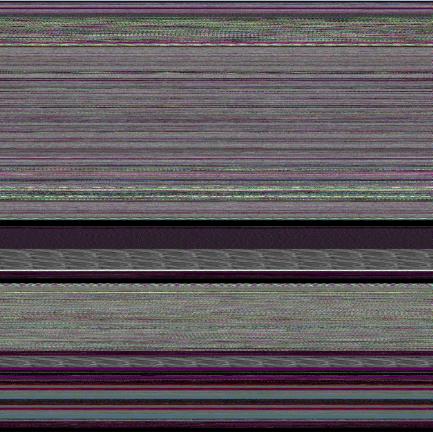
Dump2Picture can be used to explore memory leaks visually. We created the following small program in Visual C++ that leaks 64Kb every second:
#include "stdafx.h"
#include <windows.h>
int _tmain(int argc, _TCHAR* argv[])
{
while (true)
{
printf("%x\n", (UINT_PTR)malloc(0xFFFF));
Sleep(1000);
}
return 0;
}Then we sampled 3 dumps at 7Mb, 17Mb and 32Mb process virtual memory size and converted them as 16 bits-per-pixel bitmaps. On the pictures below we can see that the middle black memory area grows significantly. Obviously malloc function allocates zeroed memory and therefore we see black color.
7Mb process memory dump:
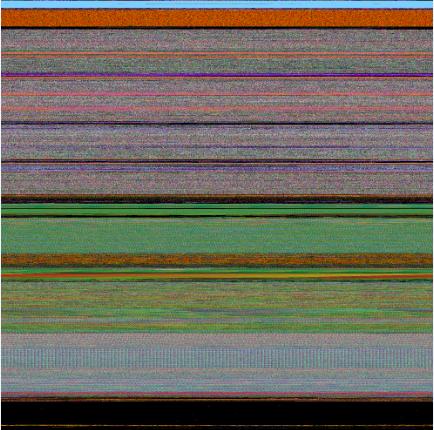
17Mb process memory dump:
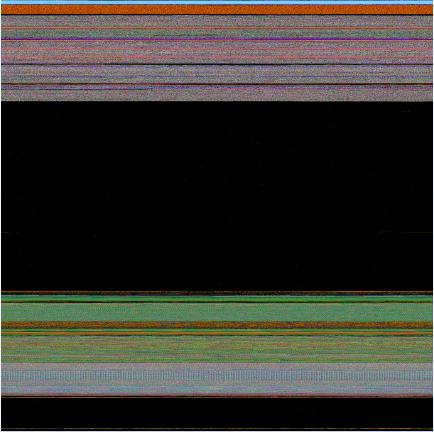
32Mb process memory dump:
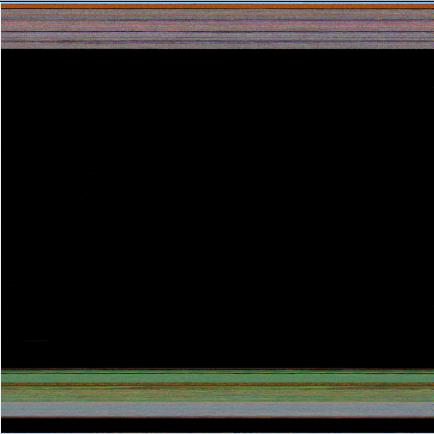
If we zoom in the black area we would see the following pattern:
Colored lines inside are heap control structures that are created for every allocated block of memory. If this is correct then allocating smaller memory blocks would create a hatched pattern. And this is true indeed. The following program leaks 256 byte memory blocks:
#include "stdafx.h"
#include <windows.h>
int _tmain(int argc, _TCHAR* argv[])
{
while (true)
{
printf("%x\n", (UINT_PTR)malloc(0xFF));
Sleep(1000/0xFF);
}
return 0;
}The corresponding process memory picture and zoomed heap area are the following:
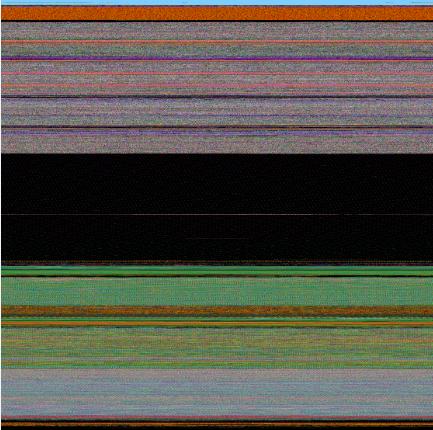
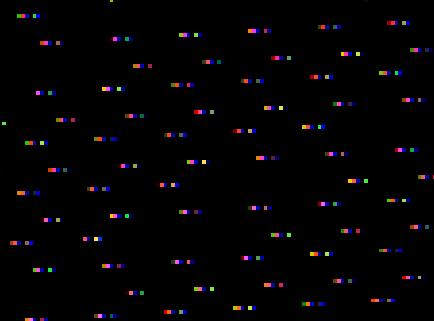
Making allocations 4 times smaller makes heap area to look hatched, and zoomed picture is more densely packed by heap control structures:
#include "stdafx.h"
#include <windows.h>
int _tmain(int argc, _TCHAR* argv[])
{
while (true)
{
printf("%x\n", (UINT_PTR)malloc(0xFF/4));
Sleep((1000/0xFF)/4);
}
return 0;
}
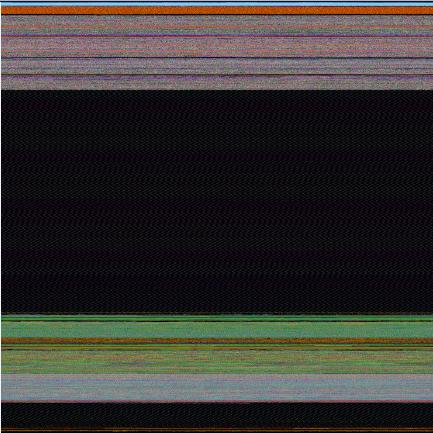
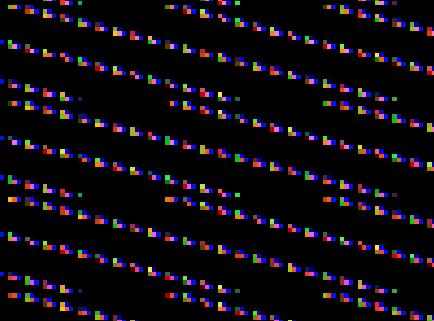
Here is another example. One service was increasing its memory constantly. The crash dump picture shows huge hatched dark region in the middle:
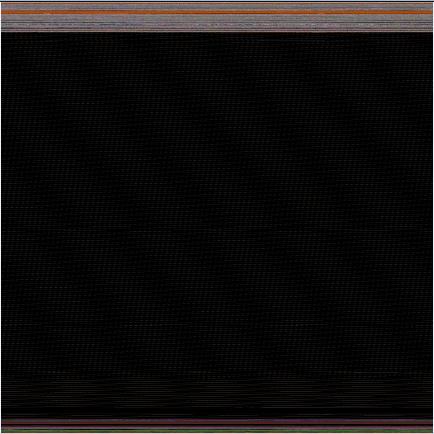
and if we zoom in this region:
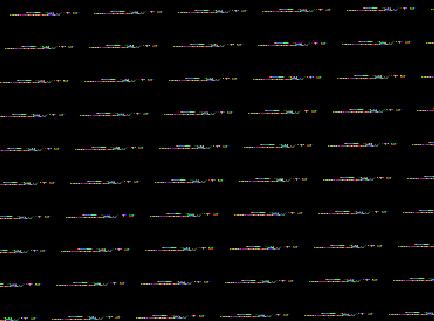
Because the pattern and allocation size look uniform it could be the true heap memory leak for some operation that allocates constant size buffers. After opening the dump and looking at heap segments that had grown the most we see the same allocation size indeed:
0:000> !.\w2kfre\ntsdexts.heap -h 5
HEAPEXT: Unable to get address of NTDLL!NtGlobalFlag.
Index Address Name Debugging options enabled
1: 00140000
2: 00240000
3: 00310000
4: 00330000
5: 00370000
Segment at 00370000 to 00380000 (00010000 bytes committed)
Segment at 01680000 to 01780000 (00100000 bytes committed)
Segment at 019C0000 to 01BC0000 (00200000 bytes committed)
Segment at 01BC0000 to 01FC0000 (00400000 bytes committed)
Segment at 01FC0000 to 027C0000 (00800000 bytes committed)
Segment at 027C0000 to 037C0000 (01000000 bytes committed)
Segment at 037C0000 to 057C0000 (02000000 bytes committed)
Segment at 057C0000 to 097C0000 (00155000 bytes committed)
...
...
...
057B96E0: 01048 . 01048 [07] - busy (1030), tail fill
057BA728: 01048 . 01048 [07] - busy (1030), tail fill
057BB770: 01048 . 01048 [07] - busy (1030), tail fill
057BC7B8: 01048 . 01048 [07] - busy (1030), tail fill
057BD800: 01048 . 01048 [07] - busy (1030), tail fill
057BE848: 01048 . 01048 [07] - busy (1030), tail fill
057BF890: 01048 . 00770 [14] free fill
Heap entries for Segment07 in Heap 370000
057C0040: 00040 . 01048 [07] - busy (1030), tail fill
057C1088: 01048 . 01048 [07] - busy (1030), tail fill
057C20D0: 01048 . 01048 [07] - busy (1030), tail fill
057C3118: 01048 . 01048 [07] - busy (1030), tail fill
057C4160: 01048 . 01048 [07] - busy (1030), tail fill
057C51A8: 01048 . 01048 [07] - busy (1030), tail fill
...
...
...
An alternative to converting memory dumps to picture files is to save a memory range to a binary file and then convert it to a BMP file. Thus we can view the particular DLL or driver mapped into address space, heap or pool region, including live memory:
To save a memory range to a file use WinDbg .writemem command:
.writemem d2p-range.bin 00800000 0085e000
or
.writemem d2p-range.bin 00400000 L20000
We wrote a WinDbg script that saves a specified memory range and then calls a shell script that automatically converts the saved binary file to a BMP file and then runs a picture viewer registered for .bmp extension.
The WinDbg script code (mempicture.txt):
.writemem d2p-range.bin ${$arg1} ${$arg2}
.if (${/d:$arg3})
{
.shell -i- mempicture.cmd d2p-range ${$arg3}
}
.else
{
.shell -i- mempicture.cmd d2p-range
}The shell script (mempicture.cmd):
dump2picture %1.bin %1.bmp %2
%1.bmp
Because WinDbg installation folder is assumed to be the default directory for both scripts and Dump2Picture.exe they should be copied to the same folder where windbg.exe is located. On our system it is
C:\Program Files\Debugging Tools for Windows
Both scripts are now included in Dump2Picture package available for free download.
To call the script from WinDbg use the following command:
$$>a< mempicture.txt Range [bits-per-pixel]
where Range can be in Address1 Address2 or Address Lxxx format, bits-per-pixel can be 8, 16, 24 or 32. By default it is 32.
For example, we loaded a complete Windows x64 memory dump and visualized HAL (hardware abstraction layer) module:
kd> lm
start end module name
fffff800`00800000 fffff800`0085e000 hal
fffff800`01000000 fffff800`0147b000 nt
fffff97f`ff000000 fffff97f`ff45d000 win32k
...
...
...
kd> $$>a< mempicture.txt fffff800`00800000 fffff800`0085e000
Writing 5e001 bytes...
C:\Program Files\Debugging Tools for Windows>dump2picture d2p-range.bin d2p-range.bmp
Dump2Picture version 1.1
Written by Dmitry Vostokov, 2007
d2p-range.bmp
d2p-range.bin
1 file(s) copied.
C:\Program Files\Debugging Tools for Windows>d2p-range.bmp
<.shell waiting 10 second(s) for process>
.shell: Process exited
kd>
and Windows Picture and Fax Viewer application was launched and displayed the following picture:
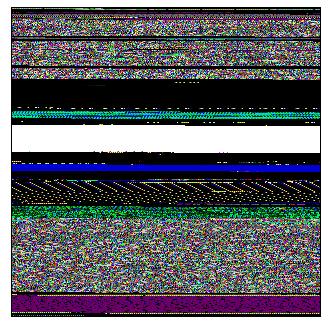
Special and General Trace and Log Analysis
Most software traces include message timestamps or have an implicit time arrow via sequential ordering. We call such traces Special. The analysis is special too because causality is easily seen. Typical examples of analysis patterns here are Discontinuity, Time Delta, Event Sequence Order, Data Flow (see time dependency markers ↓ in the training course reference), and more recently added patterns such as Back Trace, Timeout, Milestones, and Event Sequence Phase. Inter- and Intra-Correlation analysis is also easy.
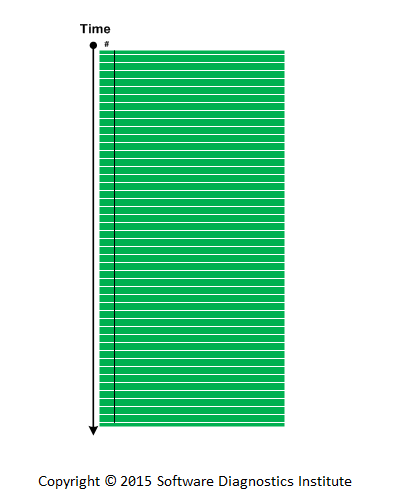
On the other side, there are plenty of software logs or digital media artefacts with “chaotic” records where time arrow is missing or only partial. Typical examples are debugger logs from WinDbg debugger from Microsoft Debugging Tools for Windows or logs from debugging sessions on other platforms. Such logs may contain global ordering such as the list of processes and threads (Last Object memory analysis pattern) interspaced with local pockets of stack traces that have reversed ordering. Some logging output may not have any ordering or timing information whatever.
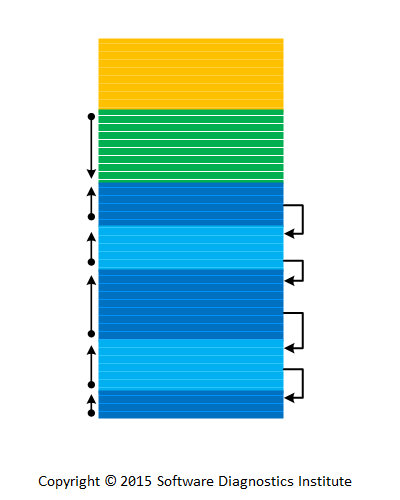
In a more general case, logging may be completely arbitrarily. Typical example is raw stack analysis and its Rough Stack Trace and Past Stack Trace patterns.
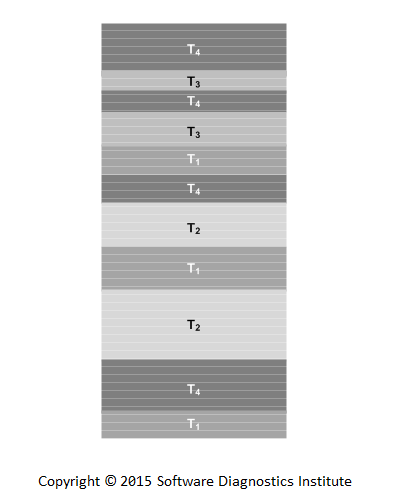
We call such traces General. The main task of general trace analysis is to recover causality. It may be possible if another analysis pattern is introduced called Causality Markers. The prototypes of such a pattern are various wait chains, Waiting Thread Time memory analysis pattern and its process memory dump equivalent.
Diagnostics, Forensics, Prognostics: The Copernican Revolution
Our pattern language system for software diagnostics was originally tool-centric, devised from recurrent analysis problems on Windows platforms when using WinDbg from Microsoft Debugging Tools for Windows. We now call it “Ptolemaic”.
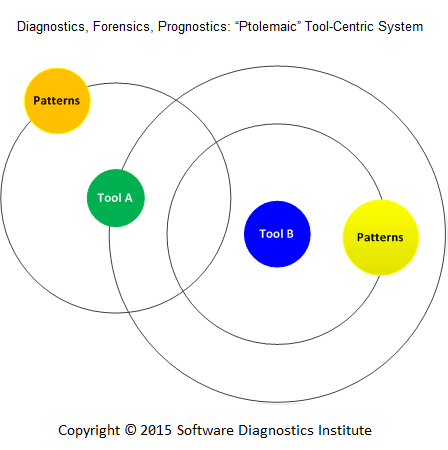
Later we realized that the same system is possible to apply to other platforms and tools, and we proved it with the publication of the book for GDB. When the debugging tool changed on Mac OS X we ported the same book to different LLDB debugger. With the presenting of a pattern language for memory forensics, we extended the same system to other memory analysis tools in principle. Our pattern language system became pattern-centric. We call it “Copernican”. In addition, trace and log analysis pattern system was devised as pattern-centric from the ground up based on software Narratology and applied to all software execution artifacts including network traces.
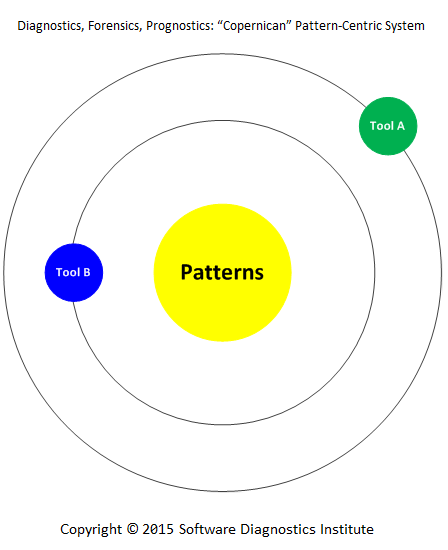
Although this paradigm shift was evolutionary for us, we call it revolutionary for the whole discipline of software diagnostics, forensics, and prognostics because of previously dominant tool-centric systems.
Pattern-Oriented Network Forensics
In February, 2015 we plan a lecture which introduces a pattern language for network forensics - investigation of captured network traces for patterns of abnormal network traffic behavior. It provides a unified language for discussing and communicating detection and analysis results, a base language for checklists, and an aid in accelerated learning. Pattern-oriented network forensics is based on a synthesis of pattern-oriented network trace analysis with malware narrative approach including malnarratives and complements pattern-oriented memory forensics.

